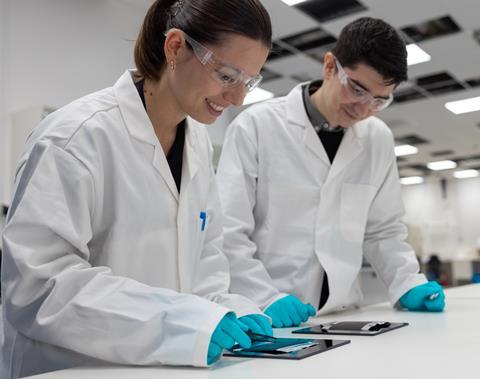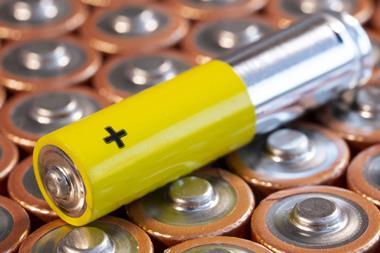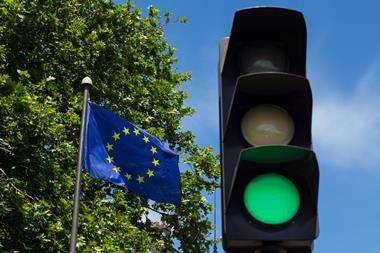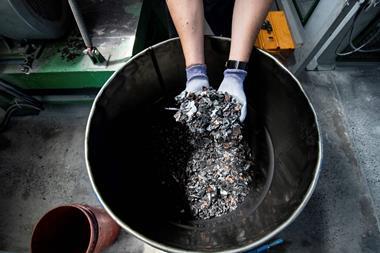Swedish firm highlights cells’ cheap and sustainable materials for energy storage
Northvolt has launched a commercial sodium-ion battery for static energy storage in Europe. The development comes much sooner than most industry observers expected to see this technology.

The Swedish battery maker emphasised that the cells will be free from lithium, nickel, cobalt and graphite. Northvolt said its battery would also be safer and more cost-effective than lithium-ion batteries. Developed with research partner Altris, the battery will use a hard-carbon anode and a cathode based on Prussian white – a derivative of the famous Prussian blue paint pigment. The company said it will be first to market a battery using these materials.
The cell achieved an energy density of over 160 Watt-hours per kilogram at the company’s R&D campus in Västerås, Sweden. ‘The energy density is practical,’ says Billy Wu, a battery chemist at Imperial College London, UK, but some way off what high-nickel variants of lithium-ion batteries can achieve – about 250–270Wh/kg. Densities around 160Wh/kg are comparable to cheaper lithium-iron-phosphate (LFP) batteries.
Na-ion battery production is primarily centred in Asia, with Chinese battery manufacturer CATL at the vanguard. But European producers haven’t been far behind. ‘I’m not surprised that Northvolt has spearheaded this development in Europe,’ says Daniel Brandell, a materials chemist at Uppsala University in Sweden. ‘But that it would go this fast took me by surprise.’
Northvolt’s first-generation sodium cell is designed mainly for static energy storage, but the company expects future generations to be suitable for vehicles. This will complement Northvolt’s automotive lithium-ion battery products, manufactured at its gigafactory in Skellefteå, Sweden. ‘The manufacturing process for sodium-ion batteries drops into a lithium-ion production line, unlike solid state batteries, where you’ve got very different processes,’ says Wu.

A major advantage of Prussian white cathodes is that they are based on combinations of sodium, iron and cyanide, and can be made from relatively cheap and more sustainable materials than NMC (nickel, manganese, cobalt) lithium-ion batteries. Other cathode materials for sodium-ion batteries, such as layered metal oxides, do not have the same sustainability and cost advantages, says Brandell, whereas polyanionic compounds have worse electrochemical performance, he explains.
‘Prussian blue analogues are really great at hosting sodium ions, allowing the ions to jump in and out [during charge and discharge],’ says Brandell. ‘You can reversibly extract sodium without the structure collapsing, which makes it robust.’ In contrast, repeated movement of ions in and out of layered metal oxide cathodes can lead to volume expansion, shifting of layers and gradual deterioration.
Another potential advantage is that sodium-ion batteries can be stored uncharged, whereas lithium-ion batteries are usually stored and transported 50–70% charged, since complete discharge can degrade the batteries. If this holds for commercial sodium cells, it brings a significant safety advantage.
While European car manufacturers still prefer lithium-ion batteries for their high energy density, and hence range, Asian companies are examining sodium-ion batteries for city cars. ‘There’s some work showing that sodium-ion batteries can be extremely fast-charging,’ says Wu. ‘You could have a smaller battery pack, which is a little heavier, but then you can fast-charge it and use it around cities.’
Earlier this year, CATL announced that its first mass-produced Na-ion batteries would debut in electric vehicles from Chery Auto. It has since been reported that battery firm BYD is to build a 30GWh/year sodium battery plant in Xuzhou, China, for cars. Meanwhile, Hina Battery has been showing off a prototype car in China with Na-ion batteries with an energy density of 140Wh/kg and a range of 252km.
Such rapid development of sodium-ion batteries ‘was not forecast,’ says Brandell. ‘Technology roadmaps in both North America and Europe had this development closer to 2030, rather than before 2025.’ Advances in materials made this possible. ‘The hard carbons are way better today than they were a couple of years ago in terms of capacity and cyclability,’ says Brandell. Hard carbons can be made from a variety of feedstocks, even biowaste and forestry residues. Meanwhile, China recently introduced restrictions on graphite exports, the material of choice for lithium-ion battery anodes.
The acceleration of sodium-ion batteries is also part of a drive to make electric vehicles with fewer critical raw materials such as lithium, nickel, cobalt, copper, rare earth elements and graphite. Automakers, for example, are trying to reduce or eliminate rare earth elements in motor magnets. ‘In terms of sustainability, there are many pros for this type of battery, because you can make it with iron and sodium, so no critical components,’ says Brandell.

















No comments yet